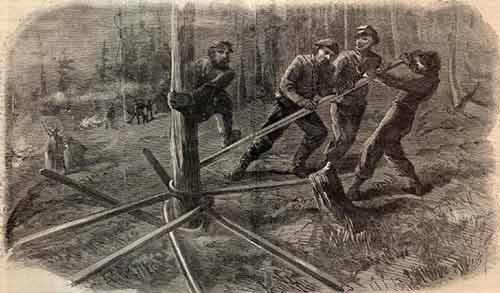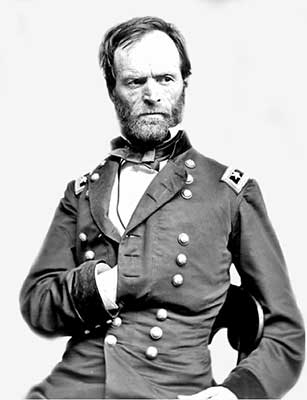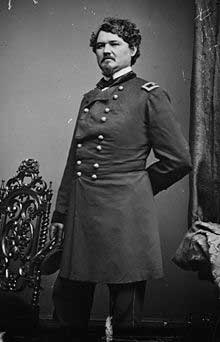
(Union Troops destroying railroad track by heating and bending them around trees. They became known as “Sherman’s Neckties” during the destruction. Image Library of Congress).
Oh, man, this could be dry as hell, but it is required for the set-up for what happened to GG Grandfather and the 72nd OVI. So, bear with me. What I want to attempt to do is get the strategic picture out there.
Vicksburg has fallen. Arkansas and Texas are cut off from the rest of the Confederacy. Union commerce is now free to traverse the length of the Mississippi River.
After the 1863 Vicksburg Campaign, Great Great Grandfather’s 72nd OVI performed “other duties as assigned. “Siege of Jackson” July 10-17, and then they burned the Rebel capital of Mississippi. Then to Brandon Station on the 19th of July; camping at the remains of the Big Black Creek Bridge until November. Expedition to Canton October 13-20. Bogue Chitto Creek October 17. Ordered to Memphis, Tenn., and guard the Memphis & Charleston Railroad at Germantown till January, 1864. Not a lot of glory in that. There certainly would be some later, though it might not be theirs.
In February of 1864 the 72nd joined Union forces under Sherman and began to march toward Meridian, MS. The town was a railroad junction and site of a Confederate arsenal, military hospital, and prisoner-of-war stockade, as well as the headquarters for a number of state offices. Sherman planned to take Meridian and, if the situation was favorable, push on to Selma, Alabama, and possibly even threaten Mobile on the Gulf Coast.
Sherman ordered Brigadier General William Sooy Smith to lead a cavalry force of 7,000 men from Memphis, Tennessee south through Okolona, along the Mobile & Ohio Railroad, and rendezvous with the rest of his Union force at Meridian.
With the main force of 20,000 men, Sherman set out for Meridian, but made feints toward various other locations. To counter the threat, Confederate President Jefferson Davis ordered troops to the area from other localities. The Confederate commander in the area, Lieutenant General Leonidas Polk, consolidated a number of commands in and around Mortona, but, lost his nerve and retreated rapidly eastward, leaving Meridian to Sherman who sacked the place when he tired of waiting for Smith to arrive.

This is what war looked like to Tecumseh Sherman: he ordered his troops “to wipe the appointed meeting place off the map” by destroying the railroads and burning much of the area to the ground. Sherman’s troops destroyed “115 mi of railroad, 61 bridges, 6,075 ft. of trestles, 20 locomotives, 28 steam cars, and 3 steam sawmills.”
After the troops departed, inhabitants of the city were without food for some days, but the soldiers had not directly inflicted any personal injuries during the attack that were reported. Sherman is reported to have said, “Meridian with its depots, store-houses, arsenal, hospitals, offices, hotels, and cantonments no longer exists.”
When Sherman left Meridian he headed west by way of Canton, which was dutifully recorded in the duty log of the 72nd OVI.
General Sooy Smith had been both remarkably indecisive, and unlucky as he ran into Nathan Bedford Forrest. Smith had delayed eleven days attempting to march toward Meridian; he wound up at West Point, fifty miles north of the city and encountered the gentleman we met yesterday, Major General Nathan Bedford Forrest and his brother, Colonel Jeffery Forrest.
At West Point, Forrest and his army forced Smith to begin to retreat to Tennessee. When Forrest saw Smith’s army retreating, he ordered his troops to chase the army down. Forrest caught Smith and his troops in Okolona, MS, and forced them to retreat more rapidly. Like, really rapidly. In the fighting, Jeffery was shot in the neck, and reportedly died in his brother’s arms.
The Confederate victory resulted in an estimated 100 Union casualties, and 50 Confederate casualties.
Frustrated by the AWOL Smith, Sherman returned to Vicksburg to plot his next moves. The 72nd OVI was committed to operations against Forrest in West Tennessee and Kentucky (March 16-April 14), then the defense of Paducah, KY, April 14, and then to Sturgis’ Expedition to Ripley, MS, April 30-May 2.
Forrest’s operations came to be called the “Defense of Mississippi, June-August 1864,” though Union General Samuel Davis Sturgis might have thought it was the other way around.

(General Samuel Davis Sturgis. Image Wikipedia).
His boss, General Sherman, had long known that his fragile supply and communication lines through Tennessee were in serious jeopardy because of Forrest’s cavalry raids. To suppress Forrest’s activities, he ordered Gen. Sturgis to conduct a penetration into northern Mississippi and Alabama with a force of around 8,500 troops to destroy Forrest and protect the railroad lifeline in Middle Tennessee. Sherman had a date with Atlanta, and he wanted nothing to prevent his making it.
Sturgis departed Memphis on the first of June with some trepidation. Forrest was notified of the movement. Already in transit to Tennessee, Forrest moved his cavalry toward Sturgis, but was unsure of Union intentions. His intentions were unambiguous. He would close with and destroy the enemy if he could.
The first two battles of the campaign were fought in Mississippi at Tupelo and Brice’s Cross Roads, also called the Battle of Tishomingo Creek.
The latter is going to be the subject of a special edition of The Daily, since it is where Nathan Bedford Forrest kicked the crap out of my family. On my birthday, of all things.
If you don’t think that made the hair on the back of my neck to go up, you clearly have another think coming.
Copyright 2015 Vic Socotra
www.vicsocotra.com
Twitter: @jayare303
